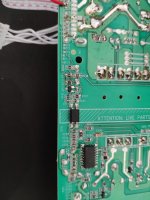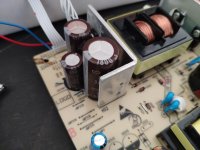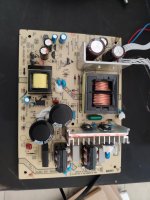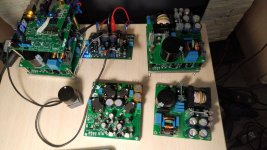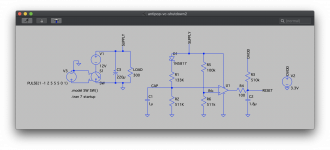I am happy. I found an easy way to mod one of my recycling power supply.
Original voltage output was 36V. I change resistor from TL431 feedback to 41.8V.
So it would be almost the same voltage as my fully charged battery pack.
The power supply is LLC and works good also under heavy load.
No thermal heating.
It has 12V auxiliary output.
I just have to wait to get my TPA3255 mono and the DSP :-(
Original voltage output was 36V. I change resistor from TL431 feedback to 41.8V.
So it would be almost the same voltage as my fully charged battery pack.
The power supply is LLC and works good also under heavy load.
No thermal heating.
It has 12V auxiliary output.
I just have to wait to get my TPA3255 mono and the DSP :-(
Attachments
Hmm, I remember that TI advises in the TPA3255 EVM documentation that inout and speakers connections need to be done prior to apply power. Hence, the recommendation of that amplifier manufacturer doesn't agree with TI's on their chip.
Best regards!
There seems to be some debate as to whether it's OK to power up without the Speakers connected. This was debated in one of the threads some time ago - I think the last time someone suggested using a circuit that isolated the speakers on power up.
The frustrating point here is that if the Anti Pop circuit (1 chip and a few SMD parts) is designed in at the point of manufacture it's probably less than a fraction of a $1 in parts. It should be a mandatory part of any TPA325x design.
That said, where you have a complete amplifier including Power Supply in a box the mains switch is usually before the Power Supply so the Anti-Pop circuit is probably not required.
Hello guys
Which MKP cap should I order on mouser
TDK B32671P4105K000 or Panasonic ECW-F2105RHA. Both are MKP
Which MKP cap should I order on mouser
TDK B32671P4105K000 or Panasonic ECW-F2105RHA. Both are MKP
I ordred 10x TDK B32671P4105K000 and 10x WIMA MKS4D041003F00JSSD
TDK Caps are not in stock... Available in 16 weeks.. that a long time :-/
Many thanks.
I will change all Caps for EKYB630E182ML40S KYB 63V 1800uF on PSU and AMPs.
So I will have good TPA3255 board.
TDK Caps are not in stock... Available in 16 weeks.. that a long time :-/
Many thanks.
I will change all Caps for EKYB630E182ML40S KYB 63V 1800uF on PSU and AMPs.
So I will have good TPA3255 board.
@hansueli, I was on Vishay MKP1839 for my other amp, but it's an axial cap. I think it's pretty good for the price. I haven't tried the TDK or the Panasonic yet.
I have simulated the anti-pop circuit and it looks like it works well.
There's a 10ms delay between flicking the switch and going low, I don't think that will be a problem.
Please note that the capacitor and resistor values can be tweaked, you do not need a 10uf.
@impuls60 you are facing a loud shutdown as increasing the capacitance will delay the shutdown time as well, that's why you will need the cut-off.
I have simulated the anti-pop circuit and it looks like it works well.
There's a 10ms delay between flicking the switch and going low, I don't think that will be a problem.
Please note that the capacitor and resistor values can be tweaked, you do not need a 10uf.
@impuls60 you are facing a loud shutdown as increasing the capacitance will delay the shutdown time as well, that's why you will need the cut-off.
Attachments
Last edited:
Swapped in opa1622 (cheap green china opamp version) and details sounded much more realistic than the stock ne5532p op amp in Aiyima 3255. I even heard a difference on some small 30 year old bookshelf speakers so the difference is easy to hear.
This amp has som hiss to it even if the components around the regulators seems to be correct. Shorting inputs didnt help either. Any ideas to what causes the hiss?
This amp has som hiss to it even if the components around the regulators seems to be correct. Shorting inputs didnt help either. Any ideas to what causes the hiss?
Swapped in opa1622 (cheap green china opamp version) and details sounded much more realistic than the stock ne5532p op amp in Aiyima 3255. I even heard a difference on some small 30 year old bookshelf speakers so the difference is easy to hear.
This amp has some hiss to it even if the components around the regulators seems to be correct. Shorting inputs didnt help either. Any ideas to what causes the hiss?
I agree with you that swapping out the stock NE5532 Op-Amps with either the OPA1622 or OPA1656 makes a very audible difference even with pretty basic speakers.
With regard Hiss. I have the same on my Aiyima A07 TPA3255. Position of the volume control also makes no difference. Digital Amps should be silent !! I can only assume that the 12 volt power supply for the Op-Amps is rather basic and generating some noise or that the main TPA3255 chip is generating noise. Funny though that this is a White Noise Hiss rather than any more specific frequencies.
I also notice that I can’t put my mobile phone anywhere near these amplifiers without generating a lot of interference !! But then that is nothing new and a lot of amplifiers seem to pick up mobile phone interference.
Maybe someone with more knowledge could shed a light on what might be the likely cause
I agree with you that swapping out the stock NE5532 Op-Amps with either the OPA1622 or OPA1656 makes a very audible difference even with pretty basic speakers.
With regard Hiss. I have the same on my Aiyima A07 TPA3255. Position of the volume control also makes no difference. Digital Amps should be silent !! I can only assume that the 12 volt power supply for the Op-Amps is rather basic and generating some noise or that the main TPA3255 chip is generating noise. Funny though that this is a White Noise Hiss rather than any more specific frequencies.
I also notice that I can’t put my mobile phone anywhere near these amplifiers without generating a lot of interference !! But then that is nothing new and a lot of amplifiers seem to pick up mobile phone interference.
Maybe someone with more knowledge could shed a light on what might be the likely cause
RFI filters are absent. OPA1656 should do better with RFI/EMI . Location of opamp is also critical along with schematic (better use good schematic to have good CMRR rejection)...the textbook implementation is far from ideal
Could this "big" changment be because the "stock" NE5532 is probably fake?
I don't thing so, because when you switch from OPA1622 to OPA1656 or OPA Burson V5i you hear the difference.
Could this "big" changment be because the "stock" NE5532 is probably fake?
Who knows !!??
From the people on here who have been swapping Op-Amps, it seems that any "quality" Op-Amp sounds better than the NE5532 which is very dry and doesn't appear to resolve the depth or sound stage of the music.
I am surprised that e3-Audio doesn't use something like the OPA1656 Op-Amps on their boards as standard - Their default is the JRC4580 Op-Amp which appears to be very old technology and people say they even upgraded to the NE5532 which seems to say a lot about this chip. I am also surprised they use SMT Capacitors in the Signal path. Would be nice if you could replace with some nice through hole Signal Caps.
As an experiment today, I attached my Amazon Echo (£22) as the source to the Aiyima A04 TPA3251 amplifier and just playing stuff from Amazon Music. Actually sounds pretty good. Some (most) of the tracks are a bit compressed but the sound stage is not bad although depth is missing from equivalent HQ sources played through my Mac Mini.
It won't replace the Mac Mini as my primary source but that has as much to do with the lack of quality of the source tracks through Amazon Music than anything else !! The Amazon Echo is just easier for casual listening and I can talk to it from the other side of the room !!
James.
Who knows !!??
From the people on here who have been swapping Op-Amps, it seems that any "quality" Op-Amp sounds better than the NE5532 which is very dry and doesn't appear to resolve the depth or sound stage of the music.
Sigh - here we go again. The NE5532 is and always has been an awesome op-amp when implemented properly (this is frequently not the case). Doug Self's book "The Design of Active Crossovers", Chapter 13 - Opamps for Active Crossovers, contains lots of good info on how to use the NE5532 correctly as well as extensive performance measurements.
As D.Self states in the book:
With tiresome inevitability, the very popularity and excellent technical performance of the 5532 has led to it being savagely criticized by Subjectivists who have contrived to convince themselves that they can tell opamps apart by listening to music played through them. This always draws a hollow laugh from me, as there is probably no music on the planet that has not passed through a hundred or more 5532s on its way to the consumer.
Sigh - here we go again. The NE5532 is and always has been an awesome op-amp when implemented properly (this is frequently not the case). Doug Self's book "The Design of Active Crossovers", Chapter 13 - Opamps for Active Crossovers, contains lots of good info on how to use the NE5532 correctly as well as extensive performance measurements.
As D.Self states in the book:
Maybe this confirms the often made comment that Chinese NE5532 Op-Amps might not be the real thing !! In these little Chinese Amplifiers just changing the originally installed "NE5532" Op-Amps has a noticeable improvement in the sound quality. Maybe just warming up the mix is more preferable to a lot of ears !! Maybe this is why they provide a socket as they know the original is crap !!
I also appreciate that a lot of professional mixers used in the recording industry use the NE5532 Op-Amps.
Doesn't explain why 3e-Audio still use an Op-Amp that is from an even earlier generation of so called Audio Op-Amps ??!!
RFI filters are absent. OPA1656 should do better with RFI/EMI . Location of opamp is also critical along with schematic (better use good schematic to have good CMRR rejection)...the textbook implementation is far from ideal
I re-raised the Hiss question as the Aiyima A07 TPA3255 Amplifiers suffer from Hiss - Not much but clearly audible if you put your head near the speakers. This is with no input. Whereas the Aiyima A04 TPA3251 Amplifiers have no Hiss whatsoever - They are silent with no input which is what I would expect from a digital amplifier.
The two PCB boards are almost identical (same layout) - Just the change of TPA325x chip and of course the TPA3255 boards use components rated at higher voltages - which means the main power supply smoothing caps are 1/3 the capacity !! The TPA3251 model also has the Anti-Pop circuitry that is missing on the TPA3255 boards.
So where is the Hiss coming from on the TPA3255 boards ?? I am using the same / identical Mean Well LRS-200-24 SMPS set to 30Volts with both boards.
I tried different bypass caps today in an attempt to find the source of the hiss. Placing bypass caps on the Ams 1117 did nothing to the hiss level. Next up was the Xl7015 and placing an input choke where the switch use to be the hiss went up in frequency. Could it be an oscillation causing the hiss? The documentation for the Xl7015 isnt very detailed. Increasing the input cap to 3x the capacitance didnt help either. Anyone elso looking into the Aiyima step down solution?
I switched the 0.1ohm resistor(or inductor?) is series with Gvdd_x with 3.3ohm resistors recommended in the TI datasheet. That didn't have an audible effect on the hiss either. The search for the hiss gremlin continues..
Sigh - here we go again. The NE5532 is and always has been an awesome op-amp when implemented properly (this is frequently not the case). Doug Self's book "The Design of Active Crossovers", Chapter 13 - Opamps for Active Crossovers, contains lots of good info on how to use the NE5532 correctly as well as extensive performance measurements.
As D.Self states in the book:
I agree. Other op-amps sound different just as different coupling caps sound different not necessarily better. It depends on music taste. I doubt that fake 5532 are used being they are so cheap in quantities. At Mouser 1,000 can be ordered at 0.21 cents each.
Yesterday I listened to one of my TPA5532 builds with a simple tube linestage and it sound much like my SE tube amplifiers. Very nice. I have 2 builds, one a TI board and the other one of the Chinese boards. I cannot tell any difference in sound between the 2. I consider my hearing really good for a 71 year old. 🙂
Last edited:
I assure you that in my stash are fake NE5532 I bought in Germany several years ago. These showed about 30dB more noise than the originals, bandwidth and DC - power consumption fitted perfectly to the cheapest op-amp ever - the LM358. These are re-labelled by the clever business people. That is quite common nowadays. And yes, you can really hear the difference!I doubt that fake 5532 are used being they are so cheap in quantities. At Mouser 1,000 can be ordered at 0.21 cents each.
Last edited:
- Home
- Amplifiers
- Class D
- TPA3255 - all about DIY, Discussion, Design etc
